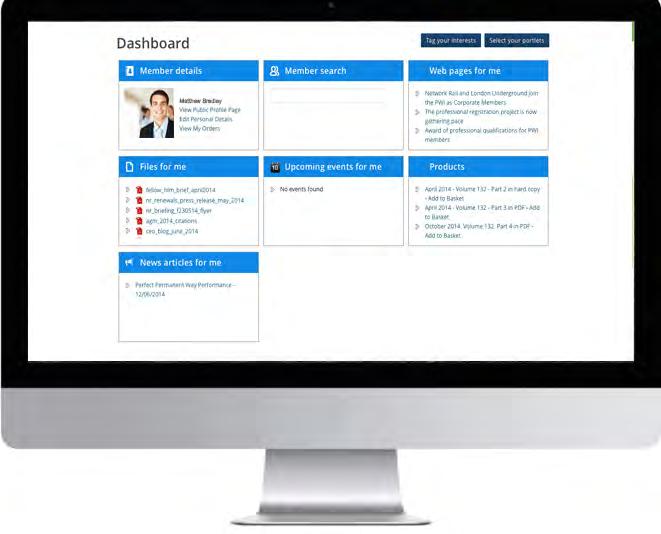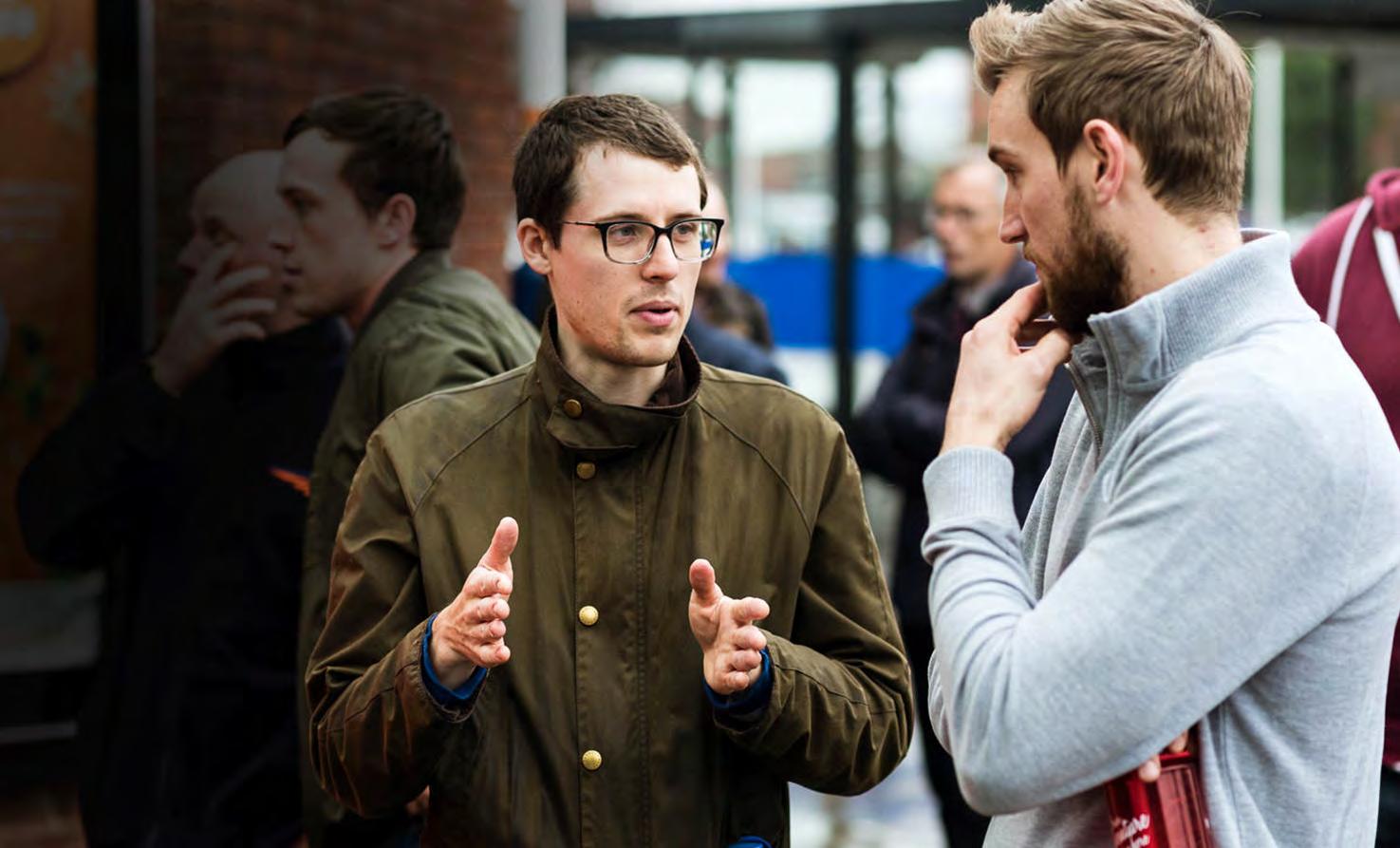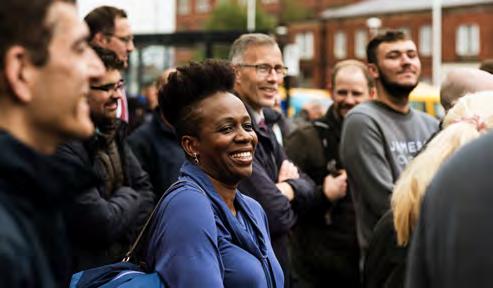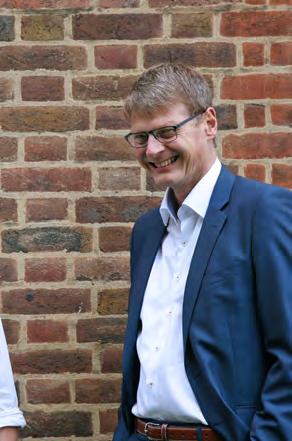
14 minute read
Rail Link to Kashmir Valley
by The PWI
AUTHOR: J.S.Mundrey
J.S.Mundrey joined Indian Railways and rose to Adviser, Civil Engineering, Indian Railway Board. After superannuation he set up his consultancy company and undertook prestigious national and international assignments, notably: writing the track maintenance manual for Malaysian Railways and conducting the final location survey for Kashmir Valley rail link. Early in his career, he won a scholarship from Confederation of British Industry, and spent one year with British Railways and Track related Industries in UK. He authored two books: “Railway Track Engineering”: published by McGraw Hill and “Bullock Cart to Bullet Train”. He is a recipient of the prestigious Indian National Award in the field of Railway Track Modernisation.
Advertisement
INTRODUCTION
Kashmir Valley, surrounded by mountains, located at a height of about 1620 m above mean sea level, with an expanse of 135 km x 32 km, is unique in many ways. Kashmir Valley is endowed with natural springs, freshwater streams, sparkling lakes, vast dense forests and mighty mountainous hill ranges. It has an abundance of fruit orchards (apple, pears, cherries, almonds, etc) and strewn with tulip flowers cultivation and enchanting saffron fields. It is a tourist paradise.
India is undertaking one of its most challenging railway projects ever by building a line to connect Kashmir Valley with the Himalayan foothills. Presently, Kashmir Valley is connected to the rest of India only through a tortuous road link. The Kashmir Railway Project (KRP) is being developed to provide an alternative and reliable transportation system to the state of Jammu and Kashmir.
The state did not have any rail link till 1972, when Jammu was connected by Indian Railways with the rest of India. Further progress towards the Kashmir Valley was made with the construction of Jammu - Udhampur rail link, which on account of its treacherous mountainous stretch and limited funding, took a long time and was completed only in 2005.
Thus, the Kashmir Railway Project (KRP) from Jammu to Baramulla consists of two stretches - the Jammu to Udhampur rail link and Udhampur to Baramulla rail link, the latter being the subject matter of this narrative. The Udhampur to Baramulla line is officially called the Udhampur-Srinagar-Baramulla rail link (USBRL).
The Udhampur–Baramulla Railway Line has been planned to connect the Kashmir Valley with Udhampur railway station and hence to the rest of India`s rail grid. The railway line, once completed, will start from Udhampur, pass through Srinagar, the capital of the provincial state of Jammu and Kashmir and will end at Baramulla. This mixed traffic railway line will encourage tourism and provide easy transport for men and material to and from the Kashmir Valley. Initially it is proposed to run about 11 pairs of passenger trains, which may get added to as the demand increases. Goods trains will carry petroleum products, construction material and other household goods to Kashmir Valley and bring back fruits and other horticulture produce from the valley.
The Udhampur-Srinagar-Baramulla Rail Link (USBRL) is the biggest project undertaken by the Indian Railways in the Himalayan Region since India gained Independence in 1947. In 2002 it was declared as a national project, funded entirely by the Central Government. The Government has also stated that the rail link is imperative for strategic consideration. The stand alone, 119 km Kashmir Valley Railway, constructed within the valley became fully operational in October 2009. It connects Baramulla in the western part of the Valley via Srinagar to Qazigund at the other end providing easy and convenient movement of passengers in the valley area.
In July 2014, the much-awaited 25 km Udhampur- Katra train service [a part of Udhampur-Baramulla rail link] was started that benefits millions of devotees, who visit the Vaishno Devi Shrine every year. The devotees can now travel from Delhi to Katra in 8 hours by a luxury semi-high-speed train to reach the base camp of the Mata Vaishno Devi Shrine.
KASHMIR VALLEY: SURVEY FOR RAIL LINK
While the Jammu-Udhampur rail link was still under construction, the Government of India decided to start the construction of a railway line beyond Udhampur to the Kashmir Valley.
The Project is divided into two phases:
Phase 1: Udhampur to Qazigund (154 km), where the line was to cross the Pir Panjal range of Himalaya, a difficult stretch, where the line is required to cross high mountains, deep gorges, a major river and many rivulets, requiring long tunnels, bridges and viaducts.
Phase 2: Qazigund to Baramulla (118 km). The entire line is comparatively on level ground in the valley without any major challenging civil works.
A preliminary survey of the route completed earlier recommended, generally following the existing road alignment. This alignment had a ruling gradient of 1 in 40 (2.5%) and curves as tight as 6o (300 metres radius). The longest tunnel proposed was 15 km long.
For undertaking any construction work it is necessary to carry out a final location survey. In this survey, which follows the preliminary survey alignment, the final alignment is pegged on the ground, cross sections are taken at about 50-60 metres intervals, and the technical details for all the civil works, including bridges, station buildings etc. are settled. The quantities of various items are worked out to include them in the tender documents floated for the execution of works. This necessarily requires extensive field work.
In view of the difficult and hazardous ground situation, inaccessible terrain, coupled with terrorist activities, Indian Railways could not find any agency to carry out the necessary field work.
After superannuating from Indian Railways as a Director/Adviser to the Civil Engineering Railway Board, I set up a consultancy company for providing technical services in the field of railway engineering.
When the Indian railways contacted me, I offered to carry out the final location survey by employing remote sensing technology. As a result of adopting remote sensing technology for finalising the rail alignment, the field work would be limited to only the marking of two mutually visible stations, on straight stretches, every ten kilometres apart. These field markings were proposed to be carried out with the help of global positioning system (GPS). The Indian Railways agreed to provide the necessary security cover during the limited field activities. The method statement for carrying out the work is described below:
• With an extensive study of the area with the help of topographical sheets and satellite imagery, mark out the possible corridors which could meet the requirements of construction parameters specified for the project, evaluating the merits and demerits of each corridor and zero down on to the best one. • Refine the alignment with the help of the latest aerial photographs available for the area. The possibility of obtaining dedicated aerial runs to be examined. • Carry out digital terrain modelling of the selected corridor to improve upon the alignment. • Mark out best possible locations of the stations, river crossings, road crossings etc. • Work out quantities and costs, and other details for incorporating in tender documents, that would be invited for the execution of the project.
It was the first time that a final location survey was proposed on Indian Railways employing remote sensing technology (which at present is increasingly being adopted with the deployment of drone and LIDAR technologies). In the year 1995, when the project was mooted to be carried out, it was a new technology, that is why the matter was deliberated at various levels of the railway administration. Our offer was finally accepted at the Railway Board, presided by the highest official, the Chairman Railway Board. After getting the go ahead, we formed a team of competent professionals for the challenging assignment. The team included an expert with a master’s degree in remote sensing technology, as applicable to engineering surveys from a University in the Netherlands.
It is to be noted that the preliminary survey for the alignment was carried out by RITES, the Indian Railway’s in-house Consultancy Company. The RITES preliminary survey had recommended a gradient of 1 in 40, much steeper than the prescribed limit of 1 in 80, requiring the provision of catch sidings, to arrest any runaway train and to operate with extra banking locomotives. Apart from other operating problems that the railway line with tight curves and steep gradient would face, it was impossible to provide catch sidings in this difficult mountainous terrain. We therefore decided to investigate the possibility of finding a longer route with less steep ruling gradients and less tight curvatures, which could enable better operating parameters without the need of extra banking locomotives.
After considerable investigation, our team carved out a longer alignment through the Reasi District limiting the gradient to 1 in 100 and curves less than 3o (600 metres radius). The new alignment meant a longer length of line but would provide great advantages of connecting with important towns en route, including Katra, which is the base town for the famous religious hill shrine of Vaishno Devi, that attracts thousands of pilgrims every year (Figure: 2):
THE CHALLENGE OF THE BRIDGE OVER CHENAB RIVER (FIGURE 3)
The bridge over the river Chenab posed a big challenge with its long span and deep gorge in a remote area without any approach roads. For this, we explored many options. In 1995 I got an opportunity to discuss with Mr. Birdsall at his New York office the possible bridge structures. Mr. Birdsall of the well-known former bridge design consultant “Steinman Boynton Gronquist & Birdsall”, confirmed the feasibility of building the bridge at the proposed site and suggested a few alternatives; one of them was a fixed steel arch bridge.
Since 1995-96 when the final location survey was completed by us, the project has undergone many reviews on account of its huge technical and financial implications, but the bridge site remained unchanged.

Figure 2: Current Alignment Jammu-Tawi to Baramulla via Katra, Banihal and Srinagar; modified from Samit Roychuodhury; “The Great Indian Railway Atlas”, third edition, September 2015, ISBN: 81-901457-3-2.
Presently, the bridge is under construction and at this time is about 80 % complete. The bridge is targeted to be completed by December 2022. When completed it will claim to be the tallest railway bridge in the world with its deck 359 m above the river level.
The following agencies are involved in the construction of the bridge.
Konkan Railway Corporation Limited (KRCL) a public sector company, under the ministry of railways, are the main contractors for the construction of railway line from km 30 to km 97, which includes the Chenab Bridge.
KRCL has appointed AFCONS an Indian Company, as a subcontractor for the construction of Chenab bridge. AFCONS have vast experience of the construction of civil works in India and abroad.
The following agencies are/have been involved in the construction of Chenab bridge:
Designers: 1. Viaduct and Foundations: Messrs WSP, Finland. 2. Arch: Messrs Leonhart and Partner (LAP), Germany. 3. Foundation Protection: Indian Institute of Science, Bangalore. 4. Cable Cranes: Designed by Messrs VCE (Austria) and construction at site by Messrs Seik, Italy. Proof Consultants: 1. Foundation & Foundation Protection: Messrs URS, UK. 2. Superstructure Viaducts & Arch (Steel): Messrs COWI, UK. 3. Slope Stability Analysis (independent consultant): Messrs ITASCA,USA. 4. Slope Stability Analysis: Indian Institute of Technology, Delhi. 5. National Institute of Rock Mechanics, Bangalore. 6. Seismic Analysis: Indian Institute of Technology, Delhi & Roorkee. 7. Wind Tunnel Test: Force Technology, Denmark.
CONSTRUCTION ACTIVITY AT THE NEW ALIGNMENT
During construction, on discovery of some geological faults, minor changes have been made in the alignment. On the revised alignment, the gradient at a few places has been made steeper to 1 in 80 and curves to five degrees, which are acceptable norms for new railway constructions on Indian Railways.
At the time of writing, the line from Udhampur to Katra has been completed and connected to the rest of the country. The railway line from Banihal to Baramulla, in the Kashmir valley, has also been completed and trains are operating in the section on a “stand alone” basis (it is not yet connected to the Indian Railway system).
The line from Katra to Banihal is still under construction. The construction on this length is posing formidable challenges, with 87% of the length in tunnels and the bridge over river Chenab with a main span of 467 m. This section is targeted to be completed by December 2022, when the Kashmir Valley will finally get a direct rail link to the whole of the Indian subcontinent.
TRACK STRUCTURE ON KASHMIR RAIL LINK
The entire track laid so far has followed the Indian Railways Track Standards for Ballasted Track Structure, which is as below:
• Rail - UIC, 60 kg ,90 UTS. • Sleepers - Mono-block Concrete Sleepers, 1660 numbers per km. • Gauge - 1,676 mm. • Ballast - 250-300 mm with 150 mm of sub ballast. • Formation - well designed and compacted.
A trial length of Rheda 2000 ballastless track had been laid in the tunnel T-25 in the Udhampur- Katra Section.
Most of the line in the remaining Katra - Banihal section is in tunnels, bridges or viaducts. It has therefore been decided to have ballastless track on this line to the extent possible.
The choice of an appropriate track structure is being made on a techno-economic consideration and also on the peculiar requirements of this single, mixed traffic line located in a difficult terrain. Presently, Indian Railways have selected the Delkor ballastless track system for a trial length of 16 kms. Based on the experience gained with this length; further contracts may be awarded. Other ballastless track systems, prevalent on world railways, are also under consideration for adoption on this line.
DELKOR BALLASTLESS FASTENING SYSTEM
This system, developed in Germany in the late 1970s, is made up of a Spheroidal Graphite Cast Iron (SGI) top plate and outer base frame, that are vulcanised (bonded) together by a natural rubber element. The underside of this rubber is specially profiled and designed to allow movement of the top plate, which holds the rail while ensuring a high degree of rail stability. The top plate can be made compatible with a range of rail fastenings including Pandrol-e type and SKL. A key feature of the baseplate is the outer frame, which encompasses the top plate making the unit fail safe. The bonded rubber element provides resilience in all six degrees of movement, which results in low vibration and thus reduced transmission of structure borne noise. This feature also reduces the dynamic stress on the anchoring elements (as the screw spikes or threaded rods secure only the outer frame which is isolated from

Figure 3: Artist’s Concept for Chenab Railway Bridge Project (image: railway-technology.com/chenab-bridgejammu-kashmir via Katra, Banihal and Srinagar; modified from Samit Roychuodhury; “The Great Indian Railway Atlas”, third edition, September 2015, ISBN: 81-901457-3-2.

Figure 4A: DELKOR Assembly for Ballast less Track (source: Avadh Rail Infrastructure Ltd. India).
the top plate by the rubber element) and virtually eliminates fatigue failures in those components.
The profiled rubber element on the bottom side of the baseplate is only exposed to compression loads with its spring characteristics becoming stiffer as the load increases. This avoids excessive deflection in the event of overloading of the track fastener. The rubber element of the baseplate is not subjected to any preload (unlike “sandwich” type designs), which ensures resistance to aging and provides good dynamic performance and a maintenance free service life (Figure: 4A and Figure: 4B).
Other design features of this baseplate system for ballastless track are: • static and dynamic stiffness - (Cstat): 16 - 35 kN/mm, Cdyn/ Cstat: < 1.4 • dual stiffness capability - vertical deflection up to 3.5 mm • proven fatigue life - tested in accordance with EN 13146, EN 1348 and other international standards • simple installation either by “top-down” or “bottom-up” construction - Lateral adjustment up to +/- 15 mm - Vertical adjustment up to + 25 mm by packer • electrical insulation - > 1 MΩ.

In the context of the Kashmir rail link advantages of the system are: • it does not require heavy machinery for its laying, a distinct advantage on the rugged mountainous terrain; • in case of damage, repair work is facilitated; • the architecture of the assembly is simple, providing scope to alter the compressive stress by changing the plate dimensions, and to engineer the elastic response of the assembly.
TO CONCLUDE
The article brings out as to how remote sensing technology helped in identifying a new route for the Kashmir Rail Link, which has all the advantages of operational efficiency and connectivity to the villages and settlements and as well to populous places. The project is giving a boost for the socio-economic development of this once remote underdeveloped district. It provides employment and income for the local population. The trajectory leading to the Kashmir rail link was a long and debated one in India. An insight into the tortuous path and the eventual solutions may provide food for thought for the presentday railway engineers engaged in survey and construction of new lines in mountainous regions.









